A Note on the q-Euler Numbers and Polynomials with Weak Weight α
Abstract
We construct a new type of q-Euler numbers and polynomials with weak weight α : , , respectively. Some interesting results and relationships are obtained. Also, we observe the behavior of roots of the q-Euler numbers and polynomials with weak weight α. By means of numerical experiments, we demonstrate a remarkably regular structure of the complex roots of q-Euler polynomials with weak weight α.
1. Introduction
The Euler numbers and polynomials possess many interesting properties are arising in many areas of mathematics and physics. Recently, many mathematicians have studied the area of the q-Euler numbers and polynomials (see [1–19]). In this paper, we construct a new type of q-Euler numbers and polynomials with weak weight α. The main purpose of this paper is also to investigate the zeros of the q-Euler polynomials with weak weight α. Furthermore, we give a table for the zeros of the q-Euler numbers and polynomials with weak weight α.
Our aim in this paper is to define q-Euler numbers and polynomials with weak weight α. We investigate some properties which are related to q-Euler numbers and polynomials with weak weight α. We also derive the existence of a specific interpolation function which interpolates q-Euler numbers and polynomials with weak weight α at negative integers. Finally, we investigate the behavior of roots of the q-Euler polynomials with weak weight α.
2. Basic Properties for q-Euler Numbers and Polynomials with Weak Weight α
Our primary goal of this section is to define q-Euler numbers and polynomials with weak weight α. We also find generating functions of q-Euler numbers and polynomials with weak weight α.
Observe that if q → 1, then and .
By (2.10), we have the following complement relation.
Theorem 2.1 (property of complement). One has
Theorem 2.2 (distribution relation). For any positive integer m(=odd), one has
Theorem 2.3. Let m ∈ ℤ+. If n ≡ 0(mod 2), then
Corollary 2.5. For n ∈ ℤ+, one has
By (2.12), one has
Theorem 2.6 (difference equation). For n ∈ ℤ+, one has
Definition 2.7. Let s ∈ ℂ.
Note that is a meromorphic function on ℂ. Note that, if q → 1, then which is the Euler zeta functions. Relation between and is given by the following theorem.
Theorem 2.8. For k ∈ ℕ, one has
Observe that function interpolates numbers at nonnegative integers. By using (2.12), we note that
Definition 2.9. Let s ∈ ℂ. Then, one has
Note that is a meromorphic function on ℂ. Obverse that, if q → 1, then which is the Hurwitz Euler zeta functions. Relation between and is given by the following theorem.
Theorem 2.10. For k ∈ ℕ, one has
3. Distribution and Structure of the Zeros
In this section, we assume that α ∈ ℕ and q ∈ ℂ, with |q | < 1. We observe the behavior of roots of the q-Euler polynomials . We display the shapes of the q-Euler polynomials , and we investigate the zeros of the q-Euler polynomials . We plot the zeros of the q-Euler polynomials for n = 10,20,30,40 and x ∈ ℂ (Figure 1). In Figure 1 (top-left), we choose n = 10, q = 1/2, and α = 3. In Figure 1 (top-right), we choose n = 20, q = 1/2, and α = 3. In Figure 1 (bottom-left), we choose n = 30, q = 1/2, and α = 3. In Figure 1 (bottom-right), we choose n = 40, q = 1/2, and α = 3.
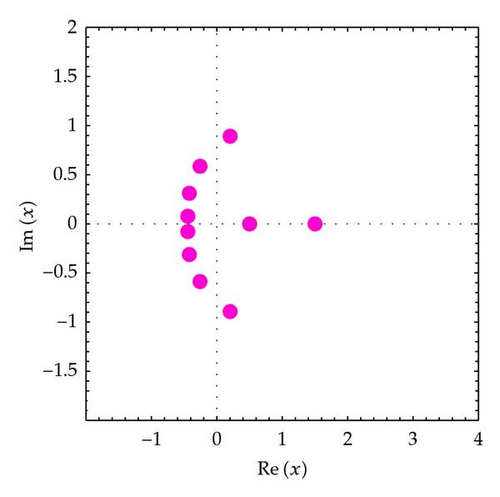
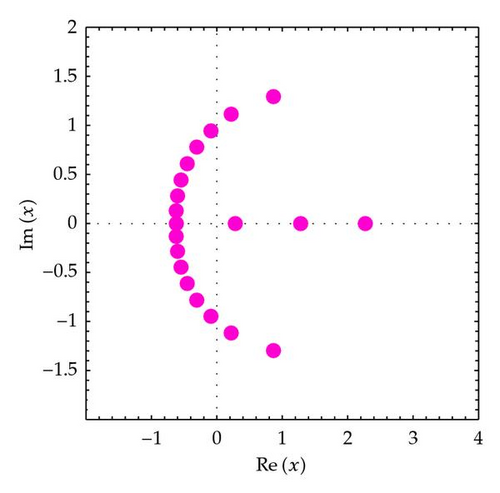
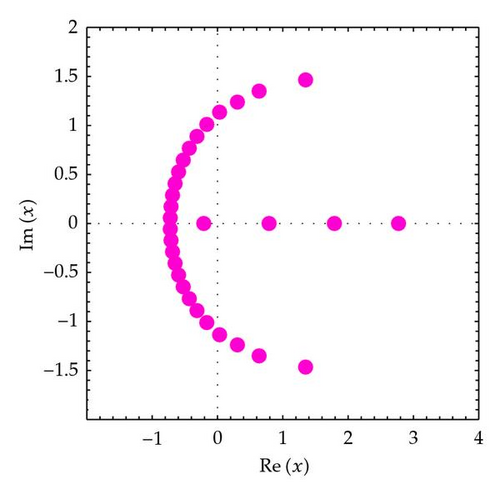
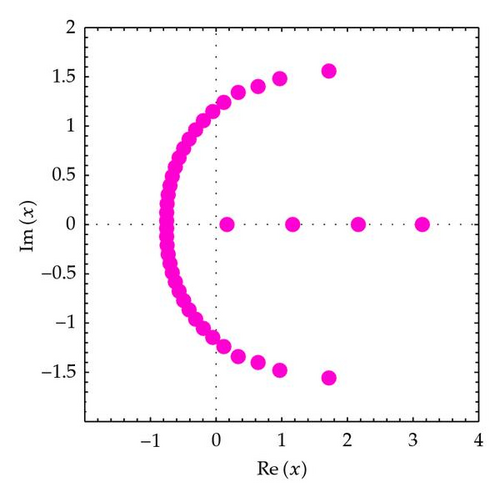
In order to understand zeros behavior better, we present Figures 2 and 3. We plot the zeros of (Figure 2).
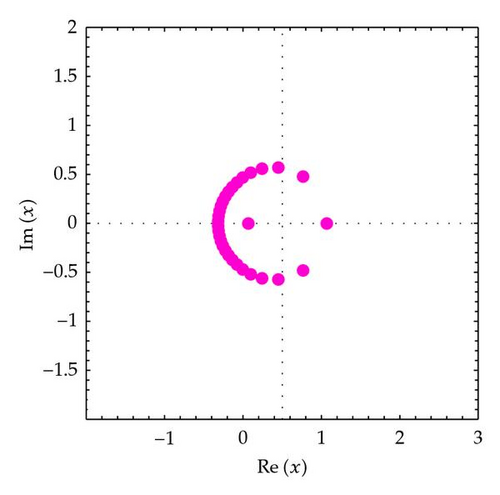
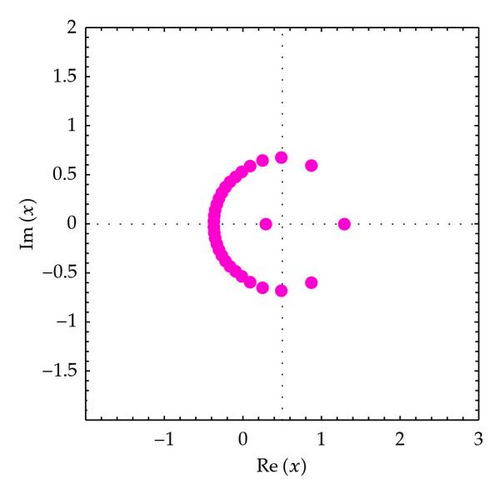
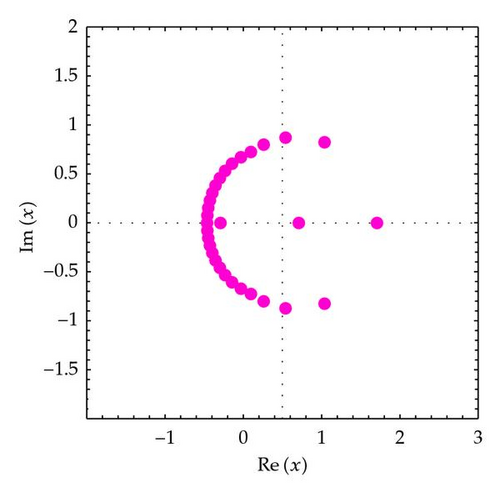
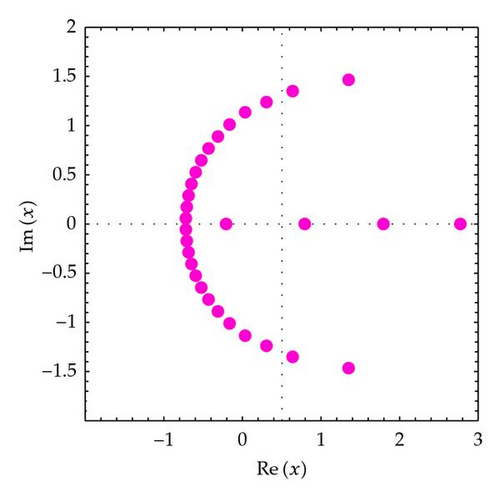
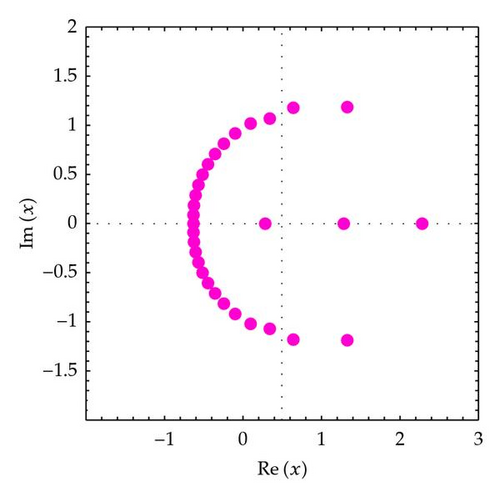
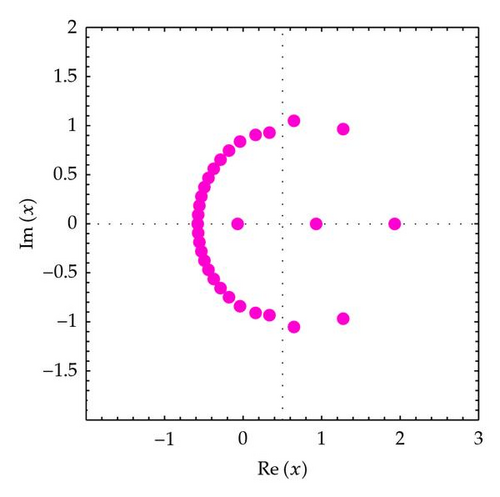
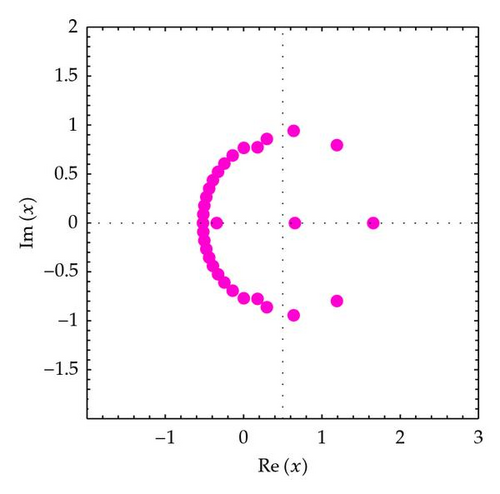
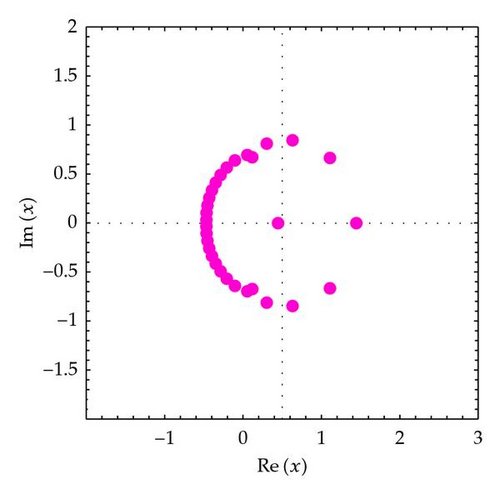
In Figure 2 (top-left), we choose n = 30, q = 1/5, and α = 3. In Figure 2 (top-right), we choose n = 30, q = 1/4, and α = 3. In Figure 2 (bottom-left), we choose n = 30, q = 1/3, and α = 3. In Figure 2 (bottom-right), we choose n = 30, q = 1/2, and α = 3.
We plot the zeros of the q-Euler polynomials for n = 30, q = 1/2, α = 5,7, 9,11 and x ∈ ℂ (Figure 3).
In Figure 3 (top-left), we choose n = 30, q = 1/2, and α = 5. In Figure 3 (top-right), we choose n = 30, q = 1/2, and α = 7. In Figure 3 (bottom-left), we choose n = 30, q = 1/2, and α = 9. In Figure 3 (bottom-right), we choose n = 30, q = 1/2, and α = 11.
Our numerical results for approximate solutions of real zeros of the q-Euler polynomials , are displayed (Tables 1 and 2).
| α = 3 | α = 5 | |||
|---|---|---|---|---|
| Degree n | Real zeros | Complex zeros | Real zeros | Complex zeros |
| 1 | 1 | 0 | 1 | 0 |
| 2 | 2 | 0 | 2 | 0 |
| 3 | 1 | 2 | 1 | 2 |
| 4 | 2 | 2 | 2 | 2 |
| 5 | 3 | 2 | 1 | 4 |
| 6 | 2 | 4 | 2 | 4 |
| 7 | 3 | 4 | 3 | 4 |
| 8 | 2 | 6 | 2 | 6 |
| 9 | 3 | 6 | 3 | 6 |
| 10 | 2 | 8 | 2 | 8 |
| 11 | 3 | 8 | 3 | 8 |
| 12 | 4 | 8 | 2 | 10 |
| 13 | 3 | 10 | 3 | 10 |
| Degree n | x |
|---|---|
| 1 | 0.0824622 |
| 2 | −0.176174, 0.301704 |
| 3 | 0.513012 |
| 4 | −0.220226, 0.701301 |
| 5 | −0.306596, −0.132473, 0.868839 |
| 6 | 0.0191767, 1.01918 |
| 7 | −0.41178, 0.155365, 1.15534 |
| 8 | 0.279948, 1.27971 |
| ⋮ | ⋮ |
Next, we calculated an approximate solution satisfying the q-Euler polynomials . The results are given in Table 2.
We observe a remarkably regular structure of the complex roots of the q-Euler polynomials . We hope to verify a remarkably regular structure of the complex roots of the q-Euler polynomials (Table 1). This numerical investigation is especially exciting because we can obtain an interesting phenomenon of scattering of the zeros of the q-Euler polynomials . These results are used not only in pure mathematics and applied mathematics, but also in mathematical physics and other areas.
Stacks of zeros of for q = 1/2, 1 ≤ n ≤ 30 from a 3D structure are presented (Figure 4).
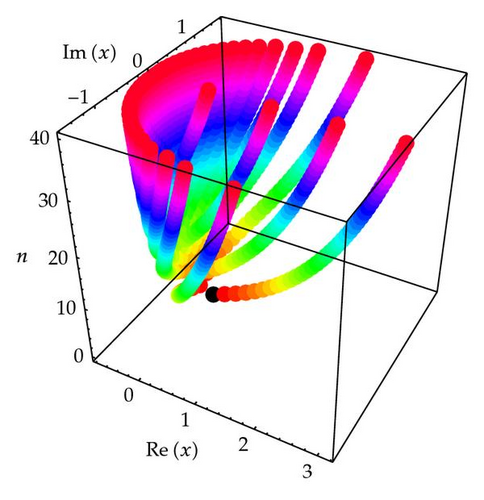
We present the distribution of real zeros of the q-Euler polynomials for q = 1/2, 1 ≤ n ≤ 30 (Figure 5).
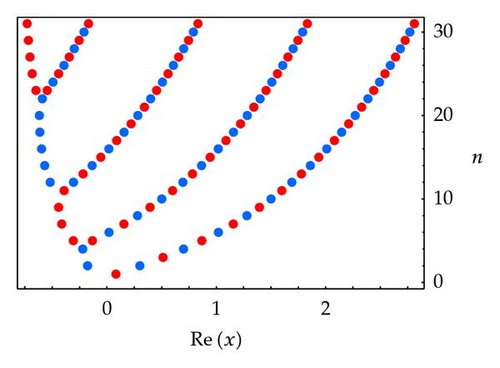
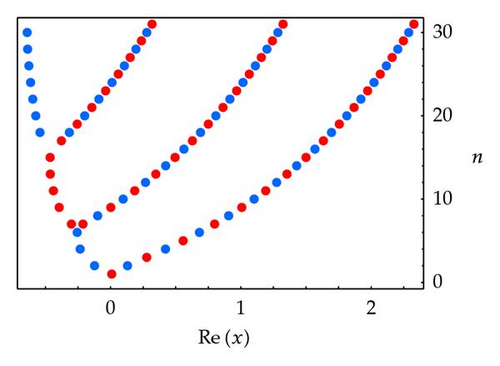
In Figure 5 (left), we choose α = 3. In Figure 3 (right), we choose α = 5.
The plot above shows for real 1/10 ≤ q ≤ 9/10 and −2 ≤ x ≤ 2, with the zero contour indicated in black (Figure 6). In Figure 6 (top-left), we choose n = 1 and α = 3. In Figure 6 (top-right), we choose n = 2 and α = 3. In Figure 6 (bottom-left), we choose n = 3 and α = 3. In Figure 6 (bottom-right), we choose n = 4 and α = 3.
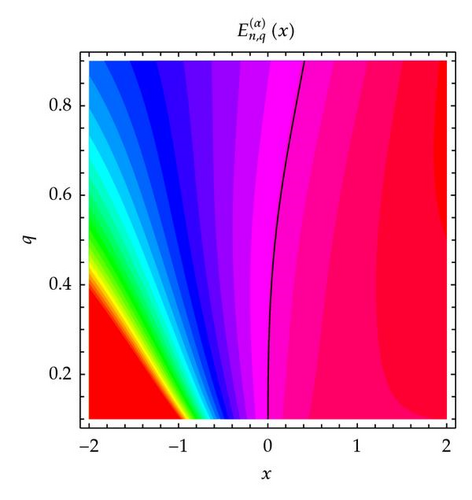
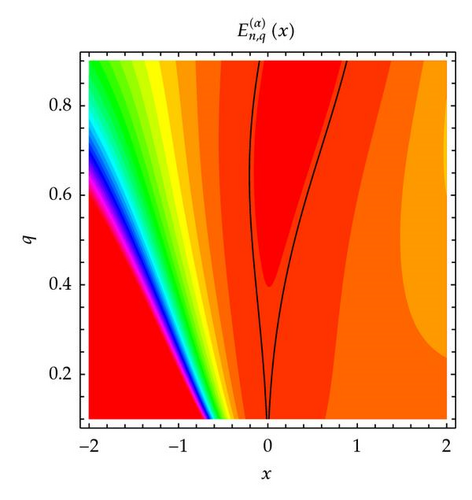
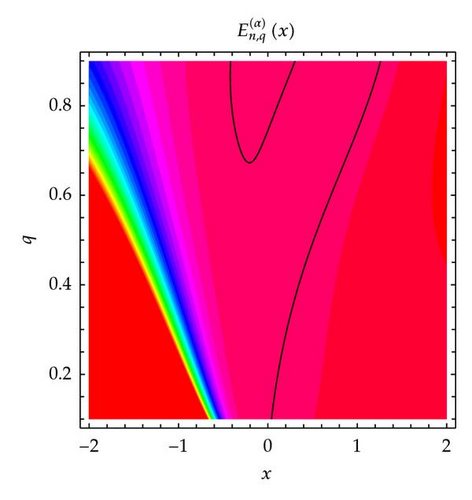
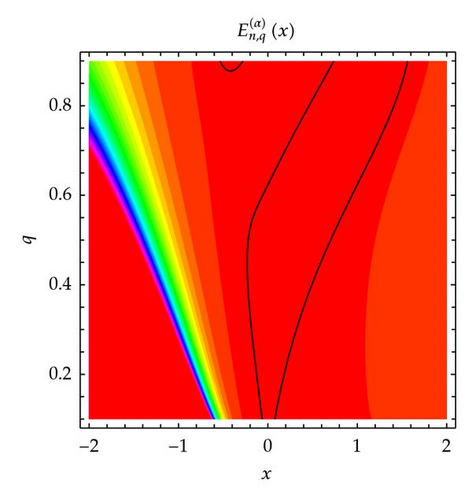
4. Direction for Further Research
We observe the behavior of complex roots of the q-Euler polynomials , using numerical investigation. How many roots does have in general? This is an open problem. Prove or disprove: has n distinct solutions, that is, all the zeros are nondegenerate. Find the numbers of complex zeros of . Since n is the degree of the polynomial , the number of real zeros lying on the real plane Im (x) = 0 is then , where denotes complex zeros. See Table 1 for tabulated values of and . We prove that , has Im (x) = 0 reflection symmetry analytic complex functions. If , then , where * denotes complex conjugate (see Figures 1, 2, and 3). The theoretical prediction on the zeros of requires further study. In order to study the q-Euler polynomials , we must understand the structure of the q-Euler polynomials . Therefore, using computer, in a realistic study for the q-Euler polynomials play an important part. The authors have no doubt that investigation along this line will lead to a new approach employing numerical method in the field of research of the q-Euler polynomials to appear in mathematics and physics. For related topics the interested reader is referred to [16].




